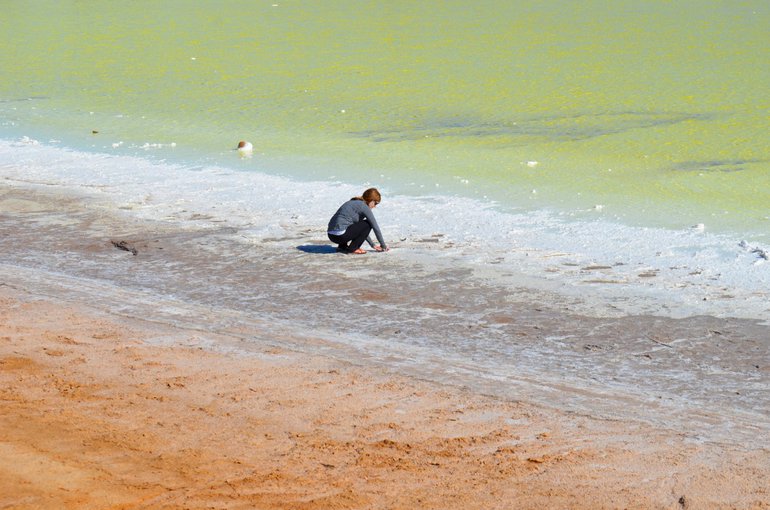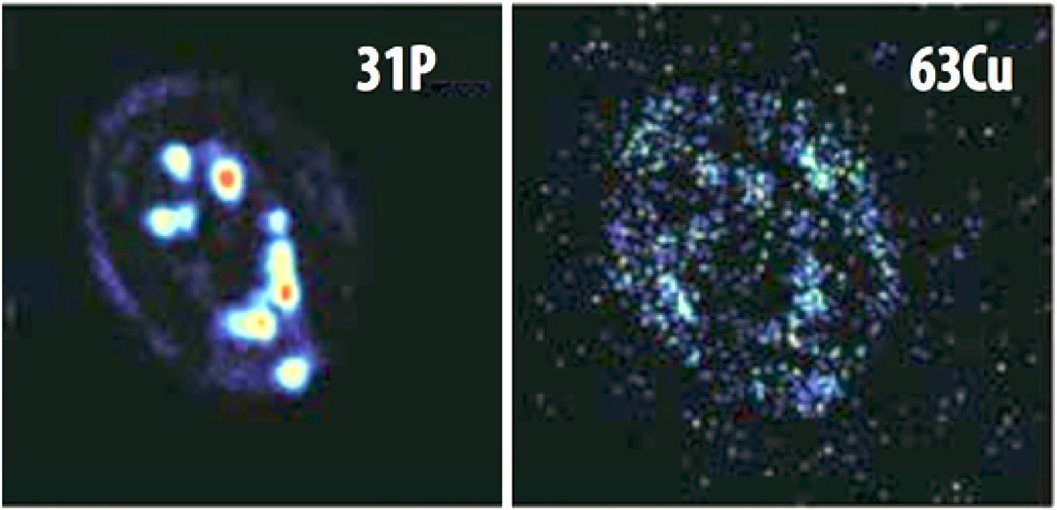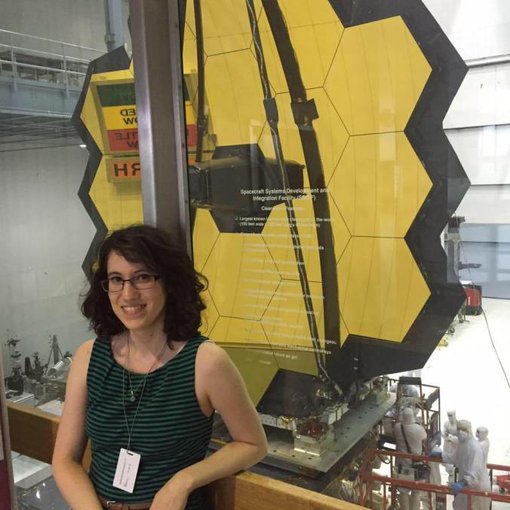
Biosignatures – evidence that says or suggests that life has been present – are often very hard to find and interpret.
Scientists examining fossilized life on Earth can generally reach some sort of agreement about what is before them, but what about the soft-bodied or even single-celled organisms that were the sum total of life on Earth for much of the planet’s history as a living domain? Scientific disagreements are common.
Now think of trying to determine whether a particular outline on an ancient Martian rock, or a geochemical or surface anomaly on that rock, is a sign of life. Or perhaps an unexpected abundance of a particular compound in one of the water vapor plumes coming out of the moons Europa or Enceladus. Or a peculiar chemical imbalance in the atmosphere of a distant exoplanet as measured in the spectral signature collected via telescope.

NASA has begun a major project to explore the potential signs of life very different from what we have on Earth. For example, groups of molecules, like those above, can be analyzed for complexity, regardless of their specific chemical constituents.Image credit: Brittany Klein/Goddard Space Flight Center.
These are long-standing issues and challenges, but they have taken on a greater urgency of late as NASA missions (and those of other space agencies around the world) are being designed to actively look for signs of extraterrestrial life – most likely very simple life – past or present.
And that combination of increased urgency and great difficulty has given rise to at least one new way of thinking about those potential signs of life. Scientists call them “agnostic biosignatures” and they do not presuppose any particular biochemistry.
“The more we explore the solar system and distant exoplanets, the more we find worlds that are really foreign,” said Sarah Stewart Johnson, at an assistant professor at Georgetown University and principal investigator of the newly-formed Laboratory for Agnostic Biosignatures (LAB). The LAB team won a five-year, $7 million grant last year from NASA’s Astrobiology Program.
“So our goal is to go beyond our current understandings and find ways to explore the world of life as we don’t know it,” she told me. “That might mean thinking about a spectrum of how ‘alive’ something might be… And we’re embracing uncertainty, looking as much for biohints as biosignatures.”

Johnson first visited the acid salt lakes of the Yilgarn Craton of Western Australia as a graduate student at MIT, and has returned multiple with colleagues to understand mineral biosignatures as well as biomarker preservation in this analog environment for early Mars. Sedimentary strata on Mars often contain a mix of sulfates, iron oxides, chlorides, and phyllosilicates (clays), a mineral assemblage unique on Earth to acid brine environments.Image credit: J. Lavinsky.
Put another way, deputy principal investigator Heather Graham at NASA’s Goddard Space Flight Center said: “Detecting life in an agnostic fashion means not using characteristics particular to Earth life. We’re working to transform how to measure biosignatures, or signs of life, in and outside of our solar system.”
This is not an easy task, to say the least. It’s somewhat like imagining a color never seen before.
So the foci are on phenomenon like the complexity of chemicals and patterns on rock surfaces, an accumulation of particular elements or compounds and evidence of the transfer of energy — all of it at levels or in distributions different from what might be expected. These are some of the reflected superstructure of life.
Johnson explained what the LAB project is looking for in more detail:
“Chemical complexity”: we’re developing new ways to determine chemical complexity using flight capable instrumentation, as recent work suggests there may be a threshold of complexity above which compounds are exceedingly unlikely to form without supporting biological machinery.”
“Elemental accumulation”: we’re looking for unexpected concentrations of elements and isotopes in compartments separate from their environments (like cells), as a kind of unexpected disequilibrium that might indicate a life form.
“Evidence of energy transfer”: the electrochemical characteristics of biotic and abiotic redox processes like iron oxidation are notably distinct, and we’re working to develop new kinds of electrochemical probes we could deploy to track those signals.”
None of these underlying dynamics presuppose a specific biochemistry and all of the approaches, Johnson said, could potentially be used on missions to other planets, moons and asteroids.

An artist rendering of hydrocarbon pools, rocky and frigid (-280 F) terrain on the surface of Saturn’s largest moon, Titan. The orange moon has hundreds of times more liquid hydrocarbons than all the known oil and natural gas reserves on Earth, according to data from NASA’s Cassini spacecraft. Astrobiologists have become especially interested in the moon as a site for testing concepts regarding “life as we don’t know it.”Image credit: Steven Hobbs; Brisbane, Queensland, Australia.
As an example, Johnson said the project’s might be especially useful in trying to think about and detect potential life on Saturn’s moon Titan, which has lakes and rivers of ethane and methane as solvents instead of water. NASA recently selected the “Dragonfly” mission to Titan as a New Frontiers endeavor, with a prospective launch date of 2026.
Johnson said she and her LAB colleagues are already beginning to have conversations with members of the Dragonfly team about “life as we don’t know it.”
Given these goals, the NASA project, and Johnson’s LAB, are and had to be broadly interdisciplinary. The NASA team includes biologists, chemists, computer scientists, mathematicians, and instrument engineers – many of them prominent researchers in their fields.
They include Paul Mahaffy of the Goddard Space Flight Center who is principal investigator of one of the major instruments on the Curiosity rover; Barbara Sherwood Lollar of the University of Toronto and 2018 Chair of the United States National Academy of Sciences Review for the Strategy for Astrobiology and the Search for Life in the Universe; and Lee Cronin of the University of Glasgow, who has a strong interest and high-profile track record regarding complex chemical systems and efforts to construct complex functional molecular architectures that are not based on biologically derived building blocks.

Sarah Stewart Johnson has run a biosignatures lab a Georgetown University for four years. “This question of why there’s something rather than nothing, and whether that something from nothing happened once or happened time and again, is something I find completely captivating,” she said. “I had the opportunity to get involved in planetary science research when I was 18 years old, working on a Mars project with a professor at Washington University, and it was the most exciting thing I’d ever done.”Image credit: Georgetown University.
They and others in LAB are a team of stars known for thinking outside the box, for bringing insights from their scientific disciplines to help identify potential extraterrestrial biosignatures beyond the molecular framework of the life we know of here on Earth.
The team is also designing tools for detecting these signatures and strategies for interpreting them.
Johnson said that while most of the group’s work is in the lab, the project also includes substantial field work at sites where extreme and ancient life can be found. An example is the Kidd Creek Mine in Ontario, where a team will be descending soon into one of the world’s deepest mines to test some of their approaches on deep subsurface rocks.
To further explain some of the meaning of agnostic biosignatures, she referred to Mars missions and what scientists have traditionally looked for.
For instance, the Sample Analysis on Mars instrument on the Curiosity rover as well as the Mars Organic Molecule Analyzer on the upcoming ExoMars mission both have the ability to detect patterns of the molecular weights of fatty acids – a staple of Earth biochemistry.
Johnson says that’s a fantastic capability, with the potential to produce extremely compelling results. The instruments can also potentially detect the degraded molecular remains of a once living organism.

One of the other approaches the LAB team is investigating is how elements and isotopes can accumulate within cells, and how those patterns are different from minerals and other precipitates. These images, captured with a technique called nanoscale secondary ion mass spectroscopy, or NanoSIMS, demonstrate distinctive accumulations of phosphorus and copper within living cells.Image credit: Slaveykova et al., 2009, Analytical and Bioanalytical Chemistry.
“If we were to discover really complex molecules in the data – even if they had lost some their functional groups, even if they weren’t the exact same chemicals that once were inside a living organism – we could potentially still see the backbones of those molecules and we might still be able reconstruct what they were.” she said.
“And if we observed a high level of complexity, it could be a strong sign that something interesting is going that might not be abiotic in origin.” (In other words, that the compounds were once part of biology.)
That way of looking for biosignatures, she said, might also have implications for the samples that will collected by NASA’s Mars 2020 rover mission for return to Earth.
Complexity is one of the key features the LAB team is focused on because life tends to create complex molecules. “Complexity may not in itself provide definitive answers,” Johnson said, “but repeated detections of complex molecules above a particular level are definitely intriguing.”
Johnson is also co-leading a newly-formed NASA Astrobiology initiative called the Network for Life Detection (NfoLD) that aims to bring together an even wider range of scientists to work on biosignatures.
NfoLD is one of five related networks established by NASA astrobiology program director Mary Voytek and others, based on the positive reception to an initial “network” called the Nexus for Exoplanet System Science (NExSS), which has focused on exoplanet formation, characterization and habitability. This column is supported by NExSS.

Giada Arney, research scientist at the Goddard Space Flight Center is an active member of the NASA NExSS program. Behind her is part of the mirror for the James Webb Space Telescope.Image credit: Goddard Space Flight Center.
Joining Johnson and me at the recent Astrobiology Science Conference (AbSciCon) outside of Seattle was Giada Arney, a research space scientist at the Goddard Space Flight Center. She is an early career scientist with a strong interest in detecting potential signs of life in distant exoplanet atmospheres.
“We know we’ll never find an exoplanet just like the Earth, or with a exoplanet biosphere like Earth’s,” she told me. “Our planet is a phenomenally great starting point, but we have to think more broadly about what life does to an atmosphere in a remotely detectable way and across interstellar distances.”
“We don’t presuppose any type of metabolisms that might have evolved on an exoplanet we’re examining. Metabolisms are so important because they’re the processes that will modify atmospheres in a profound way — producing chemicals we’ll looking for like oxygen and methane.”
“What we’re trying to do is find atmospheres that can’t be explained without invoking life, or really hard to do without invoking life. Once we find interesting atmospheres, we’ll throw chemistry at them and physics at them and geology at them and photochemistry at them to understand whatever we observed.”
“If all of these processes and more, added up together with all that we know about the planet, can’t explain the mix of gases we see in the atmosphere, then we might have to throw biology at the problem.”
In other words, in the world of agnostic biosignatures life is really the last option to explain a result after everything else has been tried.

Logo for the newly organized NASA initiative to bring together scientists working in the field of life detection.Image credit: NfoLD.
The newly-formed NfoLD group led by Johnson hopes to provide support, ideas, collaborations and more for a network of scientist working on related problems. Although NfoLD is led by researchers whose funding comes from NASA, it is not an arm of NASA per se. But it will be very much involved in building on NASA programs and will be explicitly responsive to the National Academy of Sciences study on NASA’s strategy in the search for life.
As described in its introduction:
“NfoLD is a multi-institution research coordination network focused on developing technologies and techniques for life detection on other worlds. Following on decades of research supporting and expanding our understanding of habitability, the limits of life, and habitable environments on other planets and moons, NfoLD will open the frontiers of research by catalyzing and connecting the life detection community, laying the groundwork for cutting edge studies, and allowing the quest for extraterrestrial life to venture into unexplored territories.”
The NfoLD initiative, as well as Johnson’s agnostic biosignatures lab, come at an exciting moment in the field of astrobiology and its study of the origin of life and of potential life beyond Earth.
A recent report from the National Academies of Sciences, Engineering and Medicine concluded that NASA should ramp up efforts to develop technologies capable of detecting life beyond Earth to use on future missions. The report, intended to help NASA develop its science strategy and research goals for the next 20 years, also urged the agency to encourage scientific collaborations that include a broad range of experts outside of traditional space sciences.
NfoLD will be part of that effort and is expected to provide research that will help NASA decide how to best invest its funds and to the design future missions capable of detecting life.
In addition to NfoLD, the three other sister networks being formed to join the NExSS initiative involve distant ocean worlds, prebiotic chemistry on the early Earth, and the evolution of early cellular life through multicellularity.
Both Johnson and Arney said that they thought the networks being put together by NASA astrobiology will help push their science forward. But they also said the great success of NExSS has been to form an active community of engaged scientists. They expect that NfoLD and the others coming will do the same.
Enabling robust communities of scientists who focus on questions relevant to NASA’s goals is a critical part of NASA’s work to understand the universe, advance human exploration, and inspire the next generation. As NASA’s Artemis program moves forward with human exploration of the Moon, the search for life on other worlds remains a top priority for the agency.
The Many Worlds Blog chronicles the search for evidence of life beyond Earth written by author/journalist Marc Kaufman. The “Many Worlds” column is supported by the Lunar Planetary Institute/USRA and informed by NASA’s NExSS initiative, a research coordination network supported by the NASA Astrobiology Program. Any opinions expressed are the author’s alone.
